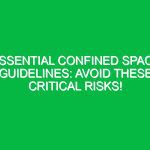Essential Confined Space Entry Procedures: Avoid These Common Risks
Confined spaces present unique challenges and Hazards in various industries, making it crucial for workers to understand the essential confined space entry procedures. These areas often contain limited access, poor ventilation, and potential exposure to hazardous materials. Understanding and implementing Safety protocols is vital to prevent accidents and ensure the Safety of everyone involved. This article outlines key aspects of confined space entry, common risks, and effective Control Measures to mitigate these risks.
Understanding Confined Spaces
What Defines a Confined Space?
A confined space is defined as an area that is not designed for continuous occupancy, has limited means of entry and exit, and may contain hazardous atmospheres. Examples include storage tanks, pipelines, and underground vaults. Recognizing these spaces is the first step in ensuring safety during entry. For instance, a worker entering a sewage treatment plant may encounter an underground tank that qualifies as a confined space due to its limited access and hazardous gases.
Have you ever worked in or near confined spaces? What challenges did you face, and how did you manage them?
Common Hazards in Confined Spaces
Identifying Potential Risks
Confined spaces can pose several serious risks, including toxic gas exposure, oxygen deficiency, and physical hazards. A notable case occurred at a manufacturing facility where workers entered a storage tank without proper ventilation. This led to a buildup of Hydrogen Sulfide, resulting in multiple hospitalizations. Such incidents highlight the importance of identifying and understanding these hazards before entry.
- Toxic Atmospheres: Gases or vapors that can cause harm.
- Oxygen Deficiency: Levels below 19.5% can lead to unconsciousness.
- Engulfment: Materials like grain or sand can suffocate.
- Physical Hazards: Moving machinery or unstable structures can pose risks.
How can you better identify these hazards in your work Environment?
Control Measures and Safety Protocols
Implementing Safe Entry Procedures
To ensure safety during confined space entry, it’s vital to follow established procedures. A comprehensive safety plan should include atmospheric testing, ventilation methods, and the use of Personal Protective Equipment (PPE). For example, before entering a chemical storage tank, a team should conduct air quality tests to check for toxic gases and ensure adequate oxygen levels. Those who entered the tank without these measures faced serious health risks.
- Conduct a hazard assessment of the confined space.
- Test the atmosphere for hazardous gases and oxygen levels.
- Establish a ventilation system to maintain air quality.
- Ensure all workers wear appropriate PPE.
- Implement a communication system for constant updates.
What specific Safety Measures are currently in place in your work area? Are there any improvements you think could be made?
Training and Responsibilities
The Importance of Education and Awareness
Training is a crucial component of confined space entry safety. Workers must be educated on recognizing confined spaces and understanding the associated risks. Additionally, roles and responsibilities should be clearly defined. For example, a supervisor at a construction site conducts regular Training sessions on confined space entry protocols, ensuring that every worker understands their role and the importance of Safety Measures. This proactive approach helps in minimizing accidents.
Have you participated in any confined space training? How did it prepare you for potential risks?
Emergency Preparedness
Planning for the Unexpected
No matter how well procedures are followed, emergencies can happen. It’s essential to have an emergency response plan tailored for confined space incidents. An example includes a warehouse that experienced a worker collapse due to oxygen deficiency. The quick response of a trained team and the presence of rescue equipment prevented a tragedy. Regular drills can ensure that everyone knows how to react in emergencies.
- Have a rescue plan in place: Ensure all workers know how to execute it.
- Conduct regular emergency drills: Practice scenarios involving confined space rescues.
- Maintain access to rescue equipment: Ensure it is readily available and functional.
What steps have you taken to ensure you’re prepared for an emergency? Are there any areas that need improvement?
Conclusion and Call-to-Action
Confined space entry procedures are critical for maintaining a safe workplace. By understanding the risks, implementing Control Measures, and prioritizing training, we can significantly reduce the likelihood of accidents. Every employee has a role in ensuring safety and compliance. Let’s commit to making safety a priority every day. Use this information in your next Toolbox Talk or safety meeting to discuss further and engage with your team on this vital topic.


